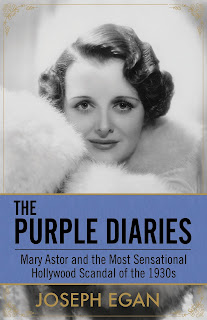THE PURPLE DIARIES: Mary Astor and the Most Sensational Hollywood Scandal of the 1930s. Joseph Egan. Diversion; 2016.
In the 1930s actress Mary Astor decided to divorce her husband, Franklyn Thorpe, apparently even before she embarked on an affair with the married playwright George S. Kaufman (whose wife was either very understanding or a complete chump). Although Kaufman was hardly anyone's idea of an especially attractive man, he apparently made Astor thrill and throb at his ministrations. Thorpe had had numerous affairs of his own, so his attitude toward the l'amours of his wife was a tad hypocritical. There was a highly publicized custody battle over Astor and Thorpe's young daughter, Marylyn (sic), in which Astor's diaries -- which included intimate details of her numerous affairs as well as those of others -- took center stage, especially in the press. (The tomes were called the "purple diaries" because the ink Astor used at least seemed purple in color.) This made the powers-that-be in Hollywood nervous at exactly which star might be mentioned in the diaries, so a special group was assembled to convince Astor to reach a quick settlement. A fabricated diary was passed around and the lawyers each did their best to either suppress the real books or introduce passages from them in court as evidence.
This is one of two books that look at the Mary Astor custody case. I haven't read the other book, but this one is well-put-together and interesting, although after awhile a reader may grow tired of this long-ago trial, the stuff of which is so commonplace today. Astor was working on the film Dodsworth while the trial proceeded, and her co-star Ruth Chatterton, who played her love rival in the film, was one of her biggest supporters and attended the trial with her nearly every day. This is not a biography or career study, so Astor's films are only mentioned in passing. The most interesting section of the book has to do with the grown-up little girl's relationship -- or lack of same -- with her parents. Apparently Astor turned into a kind of termagant who had no interest in hearing her daughter's opinion and whose attitude seemed to be "my way or the highway." Too bad.
Verdict: Interesting look at a now-forgotten chapter in Hollywood scandal history. ***.
In the 1930s actress Mary Astor decided to divorce her husband, Franklyn Thorpe, apparently even before she embarked on an affair with the married playwright George S. Kaufman (whose wife was either very understanding or a complete chump). Although Kaufman was hardly anyone's idea of an especially attractive man, he apparently made Astor thrill and throb at his ministrations. Thorpe had had numerous affairs of his own, so his attitude toward the l'amours of his wife was a tad hypocritical. There was a highly publicized custody battle over Astor and Thorpe's young daughter, Marylyn (sic), in which Astor's diaries -- which included intimate details of her numerous affairs as well as those of others -- took center stage, especially in the press. (The tomes were called the "purple diaries" because the ink Astor used at least seemed purple in color.) This made the powers-that-be in Hollywood nervous at exactly which star might be mentioned in the diaries, so a special group was assembled to convince Astor to reach a quick settlement. A fabricated diary was passed around and the lawyers each did their best to either suppress the real books or introduce passages from them in court as evidence.
This is one of two books that look at the Mary Astor custody case. I haven't read the other book, but this one is well-put-together and interesting, although after awhile a reader may grow tired of this long-ago trial, the stuff of which is so commonplace today. Astor was working on the film Dodsworth while the trial proceeded, and her co-star Ruth Chatterton, who played her love rival in the film, was one of her biggest supporters and attended the trial with her nearly every day. This is not a biography or career study, so Astor's films are only mentioned in passing. The most interesting section of the book has to do with the grown-up little girl's relationship -- or lack of same -- with her parents. Apparently Astor turned into a kind of termagant who had no interest in hearing her daughter's opinion and whose attitude seemed to be "my way or the highway." Too bad.
Verdict: Interesting look at a now-forgotten chapter in Hollywood scandal history. ***.

2 comments:
Have never read anything about Mary Astor's life and knew nothing about this scandal, so i am anxious to read this book. Have always marveled at Astor's career longevity and ability to reinvent herself, from ingenue (Red Dust) to femme fatale (Maltese Flacon) to everyone's favorite mother figure (Little Women, Meet me in St. Louis) to grande dame (Hush Hush Sweet Charlotte). Great actress and iconic star!
Keep up the great work, I always love the films and books you cover!
-Chris
Yes, she was one of the all-time greats!
Post a Comment